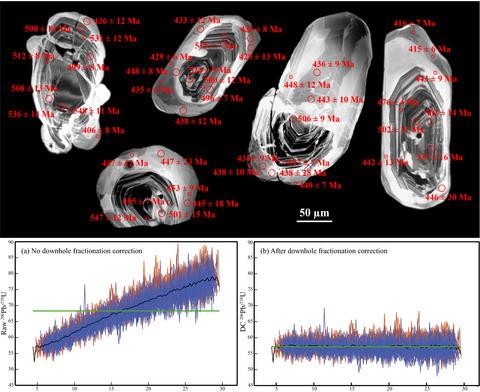当前位置:
X-MOL 学术
›
Geostand. Geoanal. Res.
›
论文详情
Our official English website, www.x-mol.net, welcomes your
feedback! (Note: you will need to create a separate account there.)
An Improved In Situ Zircon U‐Pb Dating Method at High Spatial Resolution (≤ 10 μm Spot) by LA‐MC‐ICP‐MS and its Application
Geostandards and Geoanalytical Research ( IF 2.7 ) Pub Date : 2021-01-26 , DOI: 10.1111/ggr.12374 Meng Lin 1 , Guibin Zhang 1 , Nan Li 1 , Huijuan Li 1 , Jiaxing Wang 1
Geostandards and Geoanalytical Research ( IF 2.7 ) Pub Date : 2021-01-26 , DOI: 10.1111/ggr.12374 Meng Lin 1 , Guibin Zhang 1 , Nan Li 1 , Huijuan Li 1 , Jiaxing Wang 1
Affiliation

|
In situ small‐spot U‐Pb geochronology is essential for measuring zircon crystals containing micrometre‐scale heterogeneities, abundant inclusions, inevitable cracks and narrow growth zones, all of which are especially common in metamorphic zircons. We present a high spatial resolution (≤ 10 μm diameter) laser ablation‐multi‐collector‐inductively coupled plasma‐mass spectrometry (LA‐MC‐ICP‐MS) U‐Pb dating method using a Nu Plasma II mass spectrometer coupled with a GeoLas HD laser ablation system, which is capable of analysing zircon crystals with a wide range of U contents through two analytical modes (mixed‐mode for 10 μm ablation and IC‐mode for 5 μm ablation). We examined Pb/U down‐hole fractionation (DHF) as a function of different laser settings under small‐spot ablation, and how it controls the accuracy and precision of U‐Pb ages of zircon reference materials. After DHF correction using Iolite software (version 3.71), five measurement sessions (with different laser fluence and/or laser pulse settings) for the two analytical modes yielded accurate and precise U‐Pb ages for four zircon reference materials (Plešovice, 91500, GJ‐1 and Temora‐2). Further determinations of U‐Pb ages of three metamorphic zircon samples (~ 14 to 2000 Ma) from the Himalaya, North China Craton and North Qaidam were conducted, the results of which confirm the effectiveness and feasibility of this small‐spot ablation method for natural zircons with multiple growth zones.
中文翻译:

LA-MC-ICP-MS改进的高分辨率(≤10μm光斑)原位锆石U-Pb约会方法及其应用
原位小点U-Pb地质年代学对于测量包含微米级异质性,大量夹杂物,不可避免的裂纹和狭窄的生长区的锆石晶体至关重要,所有这些在变质锆石中尤为常见。我们提出了使用Nu Plasma II质谱仪和GeoLas结合的高空间分辨率(直径≤10μm)激光烧蚀-多收集器-电感耦合等离子体质谱(LA-MC-ICP-MS)U-Pb测年方法高清激光烧蚀系统,能够通过两种分析模式(混合模式用于10μm烧蚀的混合模式和IC模式用于5μm烧蚀的模式)分析U含量范围广的锆石晶体。我们研究了在小光点烧蚀下,不同激光设置下的铅/铀井下分离度(DHF),以及如何控制锆石参考材料U-Pb年龄的准确性和精度。在使用Iolite软件(版本3.71)进行DHF校正后,针对两种分析模式进行了五次测量(具有不同的激光注量和/或激光脉冲设置),得出了四种锆石参考材料(Plešovice,91500,GJ)的准确U-Pb年龄。 ‐1和Temora‐2)。进一步测定了喜马拉雅山,华北克拉通和北柴达木的3个变质锆石样品(〜14至2000 Ma)的U-Pb年龄,这些结果证实了这种小点消融方法在自然界中的有效性和可行性。具有多个生长区的锆石。两种分析模式的五个测量会话(具有不同的激光注量和/或激光脉冲设置)可为四种锆石参考材料(Plešovice,91500,GJ-1和Temora-2)提供准确准确的U-Pb年龄。进一步测定了喜马拉雅山,华北克拉通和北柴达木的3个变质锆石样品(〜14至2000 Ma)的U-Pb年龄,这些结果证实了这种小点消融方法在自然界中的有效性和可行性。具有多个生长区的锆石。两种分析模式的五个测量会话(具有不同的激光注量和/或激光脉冲设置)可为四种锆石参考材料(Plešovice,91500,GJ-1和Temora-2)提供准确准确的U-Pb年龄。进一步测定了喜马拉雅山,华北克拉通和北柴达木的3个变质锆石样品(〜14至2000 Ma)的U-Pb年龄,这些结果证实了这种小点消融方法在自然界中的有效性和可行性。具有多个生长区的锆石。
更新日期:2021-01-26
中文翻译:

LA-MC-ICP-MS改进的高分辨率(≤10μm光斑)原位锆石U-Pb约会方法及其应用
原位小点U-Pb地质年代学对于测量包含微米级异质性,大量夹杂物,不可避免的裂纹和狭窄的生长区的锆石晶体至关重要,所有这些在变质锆石中尤为常见。我们提出了使用Nu Plasma II质谱仪和GeoLas结合的高空间分辨率(直径≤10μm)激光烧蚀-多收集器-电感耦合等离子体质谱(LA-MC-ICP-MS)U-Pb测年方法高清激光烧蚀系统,能够通过两种分析模式(混合模式用于10μm烧蚀的混合模式和IC模式用于5μm烧蚀的模式)分析U含量范围广的锆石晶体。我们研究了在小光点烧蚀下,不同激光设置下的铅/铀井下分离度(DHF),以及如何控制锆石参考材料U-Pb年龄的准确性和精度。在使用Iolite软件(版本3.71)进行DHF校正后,针对两种分析模式进行了五次测量(具有不同的激光注量和/或激光脉冲设置),得出了四种锆石参考材料(Plešovice,91500,GJ)的准确U-Pb年龄。 ‐1和Temora‐2)。进一步测定了喜马拉雅山,华北克拉通和北柴达木的3个变质锆石样品(〜14至2000 Ma)的U-Pb年龄,这些结果证实了这种小点消融方法在自然界中的有效性和可行性。具有多个生长区的锆石。两种分析模式的五个测量会话(具有不同的激光注量和/或激光脉冲设置)可为四种锆石参考材料(Plešovice,91500,GJ-1和Temora-2)提供准确准确的U-Pb年龄。进一步测定了喜马拉雅山,华北克拉通和北柴达木的3个变质锆石样品(〜14至2000 Ma)的U-Pb年龄,这些结果证实了这种小点消融方法在自然界中的有效性和可行性。具有多个生长区的锆石。两种分析模式的五个测量会话(具有不同的激光注量和/或激光脉冲设置)可为四种锆石参考材料(Plešovice,91500,GJ-1和Temora-2)提供准确准确的U-Pb年龄。进一步测定了喜马拉雅山,华北克拉通和北柴达木的3个变质锆石样品(〜14至2000 Ma)的U-Pb年龄,这些结果证实了这种小点消融方法在自然界中的有效性和可行性。具有多个生长区的锆石。










































 京公网安备 11010802027423号
京公网安备 11010802027423号